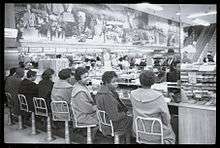Richmond 34
The Richmond 34 refers to a group of Virginia Union University students who participated in a nonviolent sit in at the lunch counter of Thalhimers department store in downtown Richmond, Virginia.
The event was one of many sit-ins to occur throughout the civil rights movement in the 1960s and was essential to helping desegregate the city of Richmond.
Background
Like many cities in the early 1960s, downtown Richmond was segregated. In department stores African Americans were allowed to buy clothes, but were not allowed to try them on or return them. The lunch counters at these department stores were either segregated or they simply did not serve African Americans at all.
Inspired by the Greensboro sit-ins and Martin Luther King Jr., who had given a talk at Virginia Union University, students planned to hold nonviolent sit-in at department stores in downtown Richmond.[1]
Actions at Thalhimer’s Department Store
On the morning of February 22, 1960, 34 students from Virginia Union University went down to Thalhimer’s Department Store located in the heart of downtown Richmond. The students then proceeded to walk into the department store and sit at the whites only lunch counter and demanded to be served. The students were then asked to leave, and when they failed to do so, were arrested and charged with trespassing. They were taken to jail, but released on bail.[2]

Legal issues
The Richmond 34 all saw court sometime in March 1960; all 34 members later appealed this decision. The case soon made it to the Virginia Supreme Court where the Richmond 34’s original conviction was upheld. The court held that it was the shop owner's constitutional right to forgo service to someone. The 34 members then decided to appeal to the Supreme Court.[3]
Their appeal came at a time where the Supreme Court and its rulings towards demonstrators was not certain. But it was at the United States Supreme Court where the convictions were finally overturned in 1963.[4] The protesters were found innocent of the alleged crimes and it was another major victory for Civil Rights in the United States.
Overall impact
For nearly a year after, African Americans set up boycotts of stores with segregated facilities and picket lines to encourage people to not buy from stores with segregation.[5]
The economic impact on downtown business was difficult to manage for the store owners, so, very quietly, they decided to integrate all of the main floor lunch counters. This, however, was not enough. The protesters continued to demand that they be served upstairs as well, for Thalhimer’s this was the restaurant called The Richmond Room. Eventually, over a year after the Richmond 34 were arrested, The Richmond Room was desegregated; a large number of the original protesters went over immediately, sat down and were served.[6]
When asked about the impact of that for him, one of the protesters, Leroy Bray said, “We were served, and it was over.[7]"
In 1963, William Thalhimer Jr. was asked by president John F. Kennedy to come to Washington to consult with him before he sent his civil rights bill to Congress.[8]
Legacy
The 50th anniversary
The Richmond 34 sit-in at Thalhimer’s Department store went largely unremembered until 2010 despite its important impact to the desegregation of Richmond and the overall civil rights movement.
In February 2010, Virginia Union University played host to a celebration for the Richmond 34. This was held in honor of the group's 50th anniversary of the sit-in and it was the first celebration of its kind for the group.[9]
In addition to the 50th anniversary celebration, the 34 also have a mile marker in downtown Richmond which marks where the Thalhimers once stood.
The film
Filmmaker Brian Bullock owner of documentary film company Bundy Films, and a Virginia Union University alumnus, is currently working on a film based on the Richmond 34 sit-in. The full-length documentary entitled, The Richmond 34 is set to release in February 2014 during Black History Month. Bullock has said that his film will not only focus on the clash between the group and local authorities for civil rights but also on the man whose store was at the center of all the attention, William B. Thalhimer.[10]
Members
- Elizabeth Patricia Johnson
- Joanna Hinton
- Gloria C. Collins
- Patricia A. Washington
- Barbara A. Thornton
- Lois B. White
- Thelma Yvonne Hickmon
- Celia E. Jones
- Carolyn Ann Horne
- Marise L. Ellison
- Virginia G. Simms
- Frank George Pinkston
- Charles Melvin Sherrod
- Albert Van Graves Jr.
- Ford Tucker Johnson Jr.
- Leroy M. Bray Jr.
- Wendell T. Foster Jr.
- Anderson J. Franklin
- Ronald B. Smith
- Larry Pridgen
- Woodrow B. Grant
- Joseph E. Ellison
- Gordon Coleman
- Milton Johnson
- Donald Vincent-Goode
- Robert B. Dalton
- Samuel F. Shaw
- Randolph A. Tobias
- Clarence A. Jones
- Richard C. Jackson
- George Wendall Harris Jr.
- John J. McCall
- Leotis L. Pryor
- Raymond B. Randolph Jr.[11]
References
- ↑ The Barriers they Broke
- ↑ Wallenstien, Peter. Blue Laws Black Codes. 2004. University of Virginia Press
- ↑ Richmond Magazine
- ↑ Wallenstien, Peter. Blue Laws Black Codes. 2004. University of Virginia Press
- ↑ Wallenstein, Peter. "Remembering a Day That Began to Change Everything." Richmond Times Dispatch. N.p., 21 Feb. 2010. Web. 23 Oct. 2012
- ↑ Wallenstien, Peter. Blue Laws Black Codes. 2004. University of Virginia Press
- ↑ Times Dispatch
- ↑ TImes Dispatch
- ↑ NBC12
- ↑ RVA News
- ↑ The Barriers they Broke
- http://www.nbc12.com/story/12023454/richmond-34-commemorate-anniversary-get-together-for-first-time-since-sit-in
- http://www.styleweekly.com/richmond/the-barriers-they-broke/Content?oid=1368704
- http://www.timesdispatch.com/news/2010/feb/14/vuuu14_20100213-221809-ar-9204/
- http://www.richmondmagazine.com/?articleID=096023f9a8216d19ad50298f18acf469
- http://www.nbc12.com/Global/category.asp?C=182900&Call=Email&Format=HTML
- http://rvanews.com/news/vuu-segregation-and-the-story-of-the-richmond-34/74803